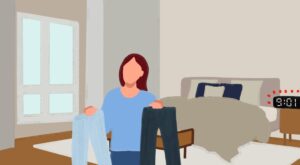Like many others, I have found myself enthralled with TikTok “day in the life” videos. And it’s not a good habit.
For months, short clips of twenty-something-year-old girls showing the best parts of their days have filled my “For You” page. These clips are often accompanied by upbeat or seasonally appropriate music and sometimes even a cheerful, bubbly voice-over.
As entertaining as these videos can be, they can also be a breeding ground for social comparison. I find myself comparing every stage of my day to the versions I see on video. From what time the narrator wakes up to the seemingly endless number of social activities she fits into her day, I wonder longingly how she makes it all work. Even more, I reflect on how dull and inadequate my daily routine seems in comparison.
When I first began watching these embarrassingly addicting videos, I tried to copy the admirable habits I saw in each daily routine. Some habits, like waking up earlier, felt like a radical change to my lifestyle—having an extra hour of productivity is great, but so is an extra hour of sleep. Other changes were pretty benign and if anything, improved my daily lifestyle by encouraging me to take a break and decompress. I started reading more, journaling, and found new snack ideas and coffee orders. But this routine felt disingenuous. Every part of my day was copied from someone else.
If there is anything I’ve learned during my time in college so far, though, it is that every person’s routine is (and should be) different. I, for example, am most productive in the mornings. At night, my brain shuts off long before many of my friends’. Because of this, I have to develop a day-to-day routine of my own, and I cannot just copy exactly what my friends—or internet influencers—may do.
The TikTok “day in the life” video poses a direct threat to the essential individuality of anyone’s productive routine. I found myself wanting to imitate these glorified daily routines, hopeful they would bring some novelty to my repetitive days.
Yet, I’ve come to realize that my day-to-day life only seems dull because I defined it that way. My daily routine has become second nature. I proceed from one activity to the next without even thinking about what I’m doing. But if I had been recording each step of my day—perhaps with a narration to accompany it—would I see my routine in a new light?
To test this theory, I challenged myself to internally narrate my day-to-day routine as if it were a “day in the life” video on TikTok. While I wasn’t prepared to take out my phone and start filming, I brought out my bubbliest, most energetic internal voice and looked at my repetitive routine through a new lens.
My daily “mental decompression” walk down the same mile-long stretch of Beacon Street became an exhilarating exploration of the cutest coffee shops Brookline has to offer. My seemingly endless hours of homework became a challenge to perfect my best handwriting in a happy pastel color scheme.
As much as these videos open the door for harsh comparison, “day in the life” vlogs on TikTok have also helped me perceive my daily routine in a new, refreshing way. Although I wasn’t actually recording the clips of my day, I became more productive. I found myself more aware of my surroundings and better able to take in the picture-perfect scenes around campus, searching for the best moments to “capture.” So, we can be cautious of social media’s traps, but we can also recognize its potential benefits.




